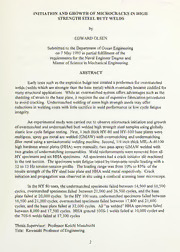
Initiation and growth of microcracks in high strength steel butt welds. PDF
Preview Initiation and growth of microcracks in high strength steel butt welds.
INITIATION AND GROWTH OF MICROCRACKS IN HIGH STRENGTH STEEL BUTT WELDS bv EDWARD QLSEN B.S., Mechanical Engineering University of South Carolina, 1985 Submitted to the Department ofOcean Engineering in Partial Fulfillment ofthe Requirements for the Degrees of Naval Engineer and Master of Science in Mechanical Engineering at the Massachusetts Institute ofTechnology May 1993 Edward Olsen, 1993 All rights reserved. The author hereby grants to MIT permission to reproduce and to distribute publiclv copies ofthis thesis document in whole or in part Protessor A Douglas Carmichael, Department ofOcean Engineering Department Graduate Committee T260800 INITIATION AND GROWTH OF MICROCRACKS IN HIGH STRENGTH STEEL BUTT WELDS by EDWARD OLSEN Submitted to the Department ofOcean Engineering on 7 May 1993 in partial fulfillment ofthe requirements for the Naval Engineer Degree and Master ofScience in Mechanical Engineering. ABSTRACT Early tests such as the explosion bulge test created a preference for overmatched welds (welds which are stronger than the base metal) which eventually became codified for many structural applications. While an overmatched system offers advantages such as the shedding ofstrain to the base plate, it requires the use ofexpensive fabrication procedures to avoid cracking. Undermatched welding ofsome high strength steels may offer reductions in welding costs with little sacrifice in weld performance or low cycle fatigue integrity. An experimental study was carried out to observe microcrack initiation and growth ofovermatched and undermatched butt welded high strength steel samples using globally elastic low cycle fatigue testing. First, 1 inch thick HY-80 and HY-100 base plates were multipass, spray gas metal arc welded (GMAW) with overmatching and undermatching filler metal using a semiautomatic welding machine. Second, 1/4 inch thick MIL-A-46100 GMAW high hardness armor plates (HHA) were manually, two pass spray welded with two grades ofundermatching consumables. Weld reinforcements were removed from all HY HHA specimens and six specimens. All specimens had a crack initiator slit machined in the test section. The specimens were fatigue tested by transverse tensile loading with a 12 to 13 Hz tension-tension profile. The loading range was from 10% to 85% ofthe HY HHA tensile strength ofthe steel base plate and weld metal respectively. Crack initiation and propagation was observed in situ using a confocal scanning laser microscope. HY In the 80 tests, the undermatched specimens failed between 14,500 and 16,500 cycles, overmatched specimens failed between 21,000 and 26,500 cycles, and the base HY plate failed at 20,000 cycles. In the 100 tests, undermatched specimens failed between 16,500 and 21,000 cycles, overmatched specimens failed between 17,800 and 21,600 HHA cycles, and the base plate failed at 32,000 cycles. All "as welded" specimens failed HHA between 8,000 and 17,500 cycles. ground 100S-1 welds failed at 10,000 cycles and the 70S-6 welds failed at 17,500 cycles Thesis Supervisor: Professor Koichi Masubuchi Title: Kawasaki Professor ofEngineering Acknowledgments I would like to extend special thanks and gratitude to the people who have helped me in this endeavor. Professor Koichi Masubuchi for his expertise, guidance and support. Professor Frank McClintock for his expertise in fracture mechanics and helping me to understand it better. Captain Osie Combs, USN, for providing the HY plate specimens and the requisite testing. Tom Melvin ofthe Army Research Laboratory for providing the HHA material specimens. Warren Mayott and Bob Pierce ofElectric Boat for preparing the HY specimen plates, their NDT, and documentation. Gene Franke ofDavid Taylor Research Center, Annapolis for allowing me to study their research material and work with the materials group during "Professional Employment". The Navy for making this MIT graduate program possible and my colleague 13A's for keeping it fun. My brothers Andy and Greg who provided me with ongoing inspiration and friendly phone calls. Dr. Sally Boyd who through her love and patience taught me the value offriendship and helped me grow immeasurably. Finally, to my wife, Kathy R, and daughter, Brooke, thanks for being there throughout these past three years. Your love and devotion have given me strength throughout these trying times.
